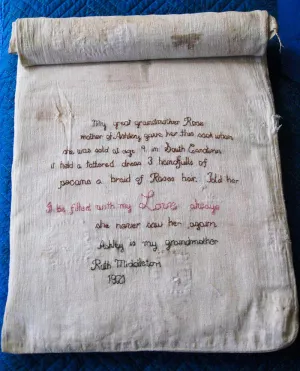For about $300, a 9-year-old girl named Ashley was sold as a slave.
Her mother, Rose, remained a house slave at a mansion in South Carolina.
This was the 1850s, roughly a decade before Abraham Lincoln’s Emancipation Proclamation, setting slaves free.
Before mother and daughter were separated, Rose gave Ashley a cotton sack. It contained a tattered dress, three handfuls of pecans and a lock of her hair. Rose told Ashley it was filled with love — always.
Ashley never saw her mom again, but she kept the sack. It was handed down through the generations, along with her story, to her granddaughter, Ruth Middleton.
...
Auslander believes this bag is a national treasure. He says we often think of slavery in the terms of suffering but, “we have to remember the narratives of resilience, of courage and of family continuity. You can't imagine a family being more terribly torn apart than by then by a slave auction of a 9-year-old little girl, but this family story continued.”
To Auslander this bag and its story tells us something profound and intimate about a vital part of American history.
Today the bag has a place of prominence. It sits next to an old slave auction block in the new Museum of African American History and Culture in Washington D.C.
Source date:
Dec 23 2016

